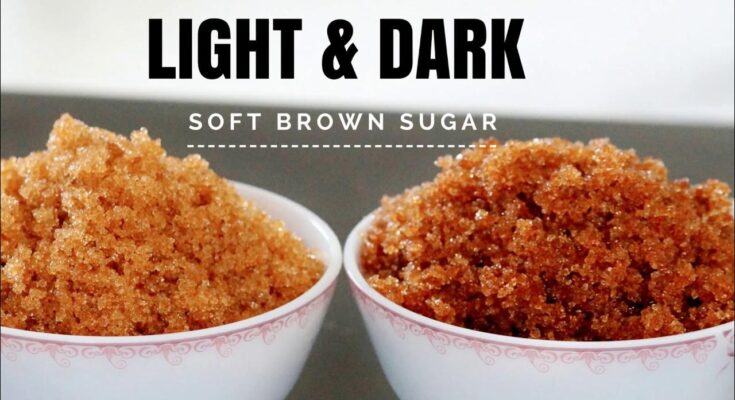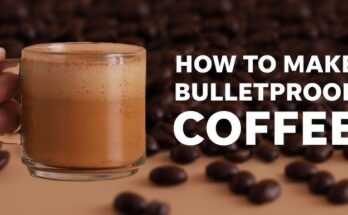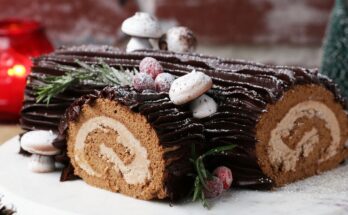Brown Sugar Recipe: Brown sugar is a pantry staple that adds a deep, caramel-like flavor to baked goods, marinades, sauces, and more. Unlike white sugar, brown sugar is composed of sucrose crystals that are coated in molasses, which gives it its rich color and distinctive taste. It’s moist, soft, and clumps slightly due to the presence of molasses—something that makes it perfect for chewy cookies, savory glazes, and hearty sauces.
Whether you’re a seasoned baker or just someone who likes to whip up the occasional batch of cookies, having brown sugar on hand is essential. But what if you run out right when you’re ready to bake? Or what if you want to avoid the additives found in commercial versions? That’s where making your own brown sugar at home becomes a game-changer.
Difference Between Light and Dark Brown Sugar
Ever wondered why some recipes specifically ask for light or dark brown sugar? It all comes down to the molasses content. Light brown sugar contains about 3.5% molasses, while dark brown sugar has around 6.5%. This small change makes a big difference in both color and flavor.
Light brown sugar has a more subtle taste and works well in recipes where you want a gentle sweetness. On the other hand, dark brown sugar has a stronger molasses flavor, making it ideal for dishes where you want that deep, rich taste to stand out—like gingerbread or barbecue sauce. When making it at home, you have the power to customize the molasses content to suit your needs, which is a fantastic advantage.
Why Make Brown Sugar at Home?
Cost-Effective Alternative
Making brown sugar at home isn’t just a cool kitchen trick—it’s also a smart financial move. Store-bought brown sugar can be overpriced, especially the organic or specialty versions. But the truth is, you only need two basic ingredients—white sugar and molasses. These are often already in your kitchen, and even if they’re not, they’re inexpensive and widely available.
Think about it: instead of buying separate packs of light and dark brown sugar, you can invest in one bottle of molasses and a bag of sugar, and whip up fresh brown sugar anytime you want. This way, you’re saving money and reducing food waste, especially if you only need a small amount for a recipe.
Fresher and Customizable
Another big plus? Freshness. Ever pulled out a box of brown sugar only to find it’s turned into a rock-hard brick? That happens because brown sugar’s moisture (from the molasses) evaporates over time. When you make it fresh at home, it’s soft, fragrant, and moist—exactly how it should be.
Plus, homemade brown sugar is fully customizable. Want a lighter flavor? Add less molasses. Craving that dark, sticky goodness? Add more. You’re in full control, which means your recipes will turn out exactly how you want them.
Ingredients Required
Only Two Ingredients Needed
You’ll be surprised at how simple this recipe is. All you need are:
- White granulated sugar – This is your base. Go for plain white sugar for the best results.
- Molasses – This adds that signature flavor and color. You can use either light or dark molasses depending on your preference.
That’s it—just two ingredients. The proportions are flexible based on whether you want light or dark brown sugar:
- For light brown sugar: Use 1 cup of white sugar + 1 tablespoon of molasses.
- For dark brown sugar: Use 1 cup of white sugar + 2 tablespoons of molasses.
Tips on Choosing the Right Molasses
Choosing the right type of molasses is key to getting the best flavor. Not all molasses are created equal. Here are your options:
- Light molasses: Mild and sweet, ideal for light brown sugar.
- Dark molasses: Richer and more intense, perfect for dark brown sugar.
- Blackstrap molasses: Extremely thick and bitter—avoid this for brown sugar making, as it can overpower the taste.
Stick with unsulphured molasses, which is cleaner and less processed. The label should say “unsulphured,” and it usually has a sweeter, more pleasant taste that’s ideal for baking and cooking.
Tools and Equipment
Kitchen Tools You’ll Need
No fancy equipment here—just basic kitchen tools you probably already have. Here’s what you’ll need:
- A medium-sized mixing bowl
- A fork or spoon (or even your fingers)
- An airtight container for storage
- Optional: a hand mixer for quicker blending
The great part is, making brown sugar is more about technique than tools. You can whip up a fresh batch in under 5 minutes using only the basics.
Substitutions and Alternatives
If you don’t have molasses, don’t worry. There are a few alternatives that can mimic the flavor of brown sugar:
- Maple syrup – Slightly different flavor, but adds a lovely depth.
- Honey – Sweeter and lighter, use in a pinch.
- Agave nectar – Works if you’re avoiding refined sugars.
- Treacle – A good substitute for molasses if it’s available in your area.
Just note that using these alternatives might change the texture and moisture content slightly, so always test in small batches first.
Step-by-Step Guide to Making Brown Sugar
Step 1: Measure Your Ingredients
Begin by deciding whether you want light or dark brown sugar. For one cup of light brown sugar, you’ll need:
- 1 cup white sugar
- 1 tablespoon molasses
For dark brown sugar:
- 1 cup white sugar
- 2 tablespoons molasses
Measure carefully to maintain consistency. Having the right balance ensures that the flavor, color, and texture all turn out just right.
Step 2: Mixing the Sugar and Molasses
Pour the white sugar into a mixing bowl. Drizzle the molasses over the top. Using a fork, spoon, or mixer, blend the ingredients thoroughly. This might take a few minutes, as molasses is thick and sticky.
If you’re mixing by hand, use a pressing and folding motion to evenly distribute the molasses. Keep going until every bit of sugar is coated, and the mixture has a uniform brown color. The longer you mix, the smoother and more cohesive your brown sugar will be.
Step 3: Storing Your Homemade Brown Sugar
Once mixed, transfer your brown sugar to an airtight container. This keeps it fresh and moist. Store it in a cool, dry place away from direct sunlight.
If your brown sugar ever hardens, just place a slice of bread or a damp paper towel in the container for a few hours—it’ll rehydrate and return to its soft, fluffy state.
How to Adjust the Flavor and Texture
Making It Lighter or Darker
One of the coolest things about making brown sugar at home is the freedom to tweak it to your taste. Prefer a gentler sweetness with less depth? Go for a lighter brown sugar by using just one tablespoon of molasses per cup of sugar. Craving a deeper, more robust flavor? Add two tablespoons for that rich, dark brown sugar profile. You can even go in between—start with one tablespoon and increase it slowly until it tastes just right.
When you’re adjusting molasses levels, do it gradually. It’s easier to add more than it is to fix an overly strong batch. Also, keep in mind that darker brown sugar has more moisture, which can slightly alter the texture of your baked goods. Expect slightly chewier cookies and richer sauces with dark brown sugar.
Playing with Flavor Add-Ins
While molasses alone gives brown sugar its classic taste, you can also experiment with fun add-ins to customize your batch:
- A drop of vanilla extract for warmth
- A sprinkle of cinnamon or nutmeg for spice
- Even a pinch of sea salt for balance
Remember to test in small amounts so you don’t overwhelm the core molasses flavor. Keep it simple, and only use a pinch of your chosen add-in per cup of sugar.
Brown Sugar Storage Tips
How to Keep It Soft
There’s nothing worse than needing brown sugar and finding a rock-hard lump in your container. Moisture is what keeps brown sugar soft, and it’s also what escapes if you don’t store it properly. To avoid that, here are some tried-and-true tricks:
- Use an airtight container – Mason jars or tight-lid plastic containers work great.
- Add a slice of bread – Sounds weird, but it works! The sugar absorbs moisture from the bread, staying soft longer.
- Use a brown sugar saver – These are little terra cotta discs you soak in water and add to your sugar. They’re reusable and super effective.
How Long Does Homemade Brown Sugar Last?
If stored correctly, homemade brown sugar can last for months—often up to six months or more. Just make sure to keep it sealed and out of the humidity. If it starts to dry out, you can easily revive it with a damp paper towel placed over the sugar in the container for a few hours.
Using Homemade Brown Sugar in Recipes
Baking with Brown Sugar
Brown sugar is a baking superstar. It’s a key ingredient in cookies, cakes, muffins, and more. Because of its molasses content, it adds moisture and chewiness to baked goods. This is why chocolate chip cookies made with brown sugar are soft and chewy, while those with white sugar tend to be crispier.
When substituting store-bought brown sugar with your homemade version, use a 1:1 ratio. Your results will be the same—or even better—because of the freshness and flavor depth of your homemade sugar.
Savory Dishes and Sauces
Brown sugar isn’t just for desserts. It’s a hero in savory dishes too. Use it in:
- BBQ sauce for that signature sweet-smoky flavor
- Marinades for pork or chicken
- Stir-fry sauces to balance salty and spicy elements
Dark brown sugar works particularly well in hearty, robust dishes where its bold flavor stands out.
Troubleshooting Common Issues
Why Is My Brown Sugar Lumpy?
If your brown sugar ends up with lumps, don’t worry—it’s totally normal. Those little clumps happen because of the moisture in molasses binding with sugar crystals. You can easily fix it by:
- Pressing it gently with a fork
- Running it briefly through a food processor
- Letting it dry slightly and breaking it apart by hand
What If I Added Too Much Molasses?
Too much molasses can make your brown sugar sticky or even overly bitter. If this happens, just add more white sugar a tablespoon at a time and mix thoroughly until the texture and taste balance out. You’re looking for soft, grainy sugar that clumps slightly—not a gooey mess.
Brown Sugar Substitutes
Best Store-Bought Alternatives
If you’re in a pinch and don’t have molasses, you can look for other brown sugar substitutes that may already be in your kitchen:
- Coconut sugar – Similar color and flavor, but less sweet
- Maple sugar – Has a unique flavor twist and natural sweetness
- Turbinado sugar – Coarser texture, but can work in a pinch
Keep in mind that these substitutes may slightly alter the texture and taste of your recipes, so they’re best used in recipes where brown sugar isn’t the star.
DIY Substitutes Without Molasses
If you don’t have molasses at all, you can combine one cup of white sugar with:
- 1 tablespoon of maple syrup
- Or 1 tablespoon of honey
These options won’t taste exactly like brown sugar, but they’ll do in a baking emergency and will still bring a richer sweetness than plain white sugar.
Health Benefits and Nutritional Info
Is Brown Sugar Healthier Than White Sugar?
There’s a common belief that brown sugar is healthier than white sugar—but is it true? Not exactly. While brown sugar contains trace minerals like calcium, potassium, iron, and magnesium thanks to the molasses, the amounts are minimal. You’d have to eat a ton of brown sugar to see any real health benefit, which obviously isn’t recommended.
Nutritionally, both white and brown sugar are nearly identical. Brown sugar does have slightly fewer calories per gram due to its moisture content, but the difference is negligible. So if you’re trying to pick the healthier sugar, neither really wins. The best bet is to enjoy both in moderation.
That said, brown sugar does have a richer flavor, which means you may find yourself using less of it to achieve the same taste impact. That’s a small win if you’re trying to cut back without sacrificing flavor.
Sugar Alternatives for Health-Conscious Bakers
If you’re looking to cut sugar entirely or reduce your intake, consider natural alternatives:
- Stevia – Great for beverages and some baked goods, though it lacks brown sugar’s texture.
- Erythritol or Monk Fruit Blends – These mimic sugar well and come in brown sugar-style versions too.
- Date Sugar – Made from ground dates, it has fiber and nutrients, though it doesn’t melt or dissolve as smoothly.
These aren’t perfect substitutes for brown sugar in every recipe, but they offer options for health-conscious cooking.
Cultural and Culinary Importance
Global Uses of Brown Sugar
Brown sugar isn’t just an American baking staple—it’s cherished around the world. In Asia, it’s often used in teas, stews, and even savory sauces. Chinese cooking, for example, uses “black sugar” (a type of unrefined brown sugar) in traditional desserts and herbal drinks for its health benefits and warming properties.
In Latin American cuisine, brown sugar variations like panela or piloncillo are common in both sweet and savory dishes. They’re unrefined and rich in molasses flavor, similar to dark brown sugar. You’ll find them in everything from hot drinks to caramel sauces.
In Caribbean cooking, brown sugar is a key player in jerk marinades, sweet breads, and sauces. Its robust flavor pairs well with spices, citrus, and smoky ingredients.
Cultural Traditions Involving Brown Sugar
Beyond food, brown sugar is often linked to cultural traditions. In some Asian countries, brown sugar tea is considered a healing drink for postpartum women. In many holiday traditions worldwide, brown sugar finds its way into cookies, cakes, and festive drinks, symbolizing warmth, abundance, and celebration.
This shows that brown sugar is more than just a sweetener—it’s a cultural bridge that brings richness and depth to traditions across the globe.
DIY Gift Ideas Using Homemade Brown Sugar
Brown Sugar Scrub
Looking for a thoughtful, inexpensive gift? Try making a homemade brown sugar scrub! Brown sugar’s gentle texture makes it a perfect natural exfoliant for the skin. Here’s a simple recipe:
- 1 cup brown sugar
- ½ cup coconut oil or olive oil
- Optional: a few drops of essential oil (like lavender or peppermint)
Mix all ingredients and store in a mason jar. Add a ribbon or a custom label, and you’ve got a luxurious, spa-like gift anyone will love.
Brown Sugar Gift Jars
Another fun idea? Layer white sugar and molasses in a jar, and include a recipe card for how to mix it into brown sugar. It’s a cute, crafty way to share your kitchen know-how with friends and family. This is especially great during the holidays or as a hostess gift.
FAQs about Brown Sugar Recipe
Q1: Can I use brown sugar immediately after making it?
Yes! Homemade brown sugar is ready to use immediately. Just make sure it’s well mixed and evenly blended before adding it to recipes.
Q2: How do I store homemade brown sugar long-term?
Keep it in an airtight container at room temperature. To prevent drying out, you can add a slice of bread or a terra cotta brown sugar saver.
Q3: Can I use other types of sugar to make brown sugar?
Technically, yes. You can use raw or cane sugar, but the texture and flavor may vary. White granulated sugar is best for the most consistent results.
Q4: What if I don’t have molasses—what’s the best substitute?
Try using maple syrup, honey, or agave nectar. The taste will be different, but they can work in a pinch for recipes that don’t rely heavily on molasses flavor.
Q5: Why does homemade brown sugar taste better than store-bought?
Freshness! Homemade brown sugar doesn’t sit on shelves, so it retains more moisture and aroma. Plus, you can tailor the flavor to your exact preference.
Conclusion
Making brown sugar at home is one of those kitchen hacks that feels like a secret superpower. With just two simple ingredients—white sugar and molasses—you can whip up fresh, soft, delicious brown sugar in minutes. Whether you want light or dark, mild or bold, this DIY recipe puts you in control. You save money, avoid unnecessary additives, and get better-tasting results every time.
Beyond that, homemade brown sugar opens up a world of creative possibilities—from baking to savory cooking, from global dishes to beauty products. It’s easy, versatile, and totally customizable. Once you try it, you’ll wonder why you ever bought the packaged stuff.



